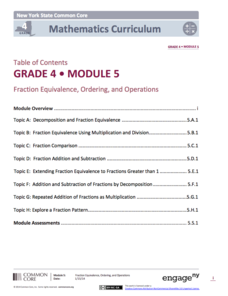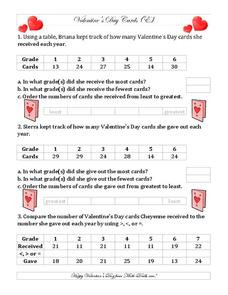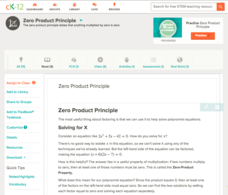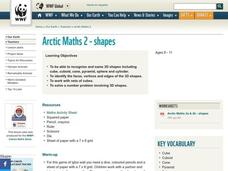EngageNY
The Division Algorithm—Converting Decimal Division into Whole Number Division Using Mental Math
Make math much simpler with mental math methods. The 16th installment in a series of 21 looks at ways scholars can apply mental math to convert division problems into easier problems with the same quotient. Multiplying or dividing both...
Curated OER
Mental Math: Adding 10s
To develop mental math skills for adding 10s, learners read an example, solve one carefully scaffolded problem, and then complete 6 more independently. Pictures of 10-rods make the connection between sets of 10 and the corresponding...
EngageNY
Grade 5 Math Module 1, Topic C, Lesson 8
Go another round on rounding. Pupils refine their learned rounding skills in the eighth installment in an 18-part unit on decimals. The lesson takes away some of the previous scaffolding to encourage scholars to use the procedures that...
Curated OER
Math in English Skills X Exercise Book
Provide your remedial math students with a handy packet that will help them practice prime factorization, exponents and roots, and multiplication and division of fractions. The packet includes 20 pages, bright images, and answer keys....
Curated OER
Math in English Skills IX Exercise Book
Wouldn't it be great if you had a packet of worksheets that covered percents, adding, dividing, and comparing fractions and decimals? Click here and print a workbook with over 20 well-scaffolded pages that will help your class practice...
Curated OER
Math in English Skills V Exercise Book
Long division, multiple-digit multiplication, rounding, and place values are all covered in a fantastic math packet. The packet contains over 20 worksheets and puzzles, and their answer keys, that will help remedial math students in a...
Curated OER
Math in English Skills III Exercise Book: Understanding Fractions
Fractions can be tricky, and there is no better way to tackle tricky topics than with a visual representation. Intended for learners in grades two and three, this set of printable worksheets provides a variety of fractions represented in...
Virginia Department of Education
Modeling Division of Fractions
Provide a meaningful context for learning about the division of fractions with this upper-elementary math lesson. Presented with a simple, real-world problem, young mathematicians work in small groups to develop visual models that help...
EngageNY
Fraction Equivalence, Ordering, and Operations
Need a unit to teach fractions to fourth graders? Look no further than this well-developed and thorough set of lessons that takes teachers through all steps of planning, implementing, and assessing their lessons. Divided into eight...
EngageNY
Fluency with Percents
Pupils build confidence working with percents as they work several types of percent problems to increase their fluency. The resource contains two sets of problems specifically designed to build efficiency in finding solutions of basic...
Education Development Center
Distance, Rate, and Time—Walking Home
Dig into a classic math problem with your classes. Through an engaging task, learners work with rate and distance information to make conclusions. In the task, two people walk at different rates; one leaves first, and scholars calculate...
Math Drills
Valentine's Day Ordering and Comparing (E)
Love is in the air, and in a math table! Young learners chart the number of cards from each grade from least to greatest in three Valentine's Day word problems.
CK-12 Foundation
Zero Product Principle
Some lessons feature videos, some interactive practice problems, and some have notes and activities. This comprehensive look at factoring and solving polynomial equations using the zero product principle has all of this and more. Though...
PBS
Human Tree: Ratios
Create a personal tree. By visiting an exhibit at the National Museum of Mathematics, the resource introduces the idea of fractals. The exhibit takes an image of the person and creates a tree by repeating scaled images on the shoulders...
EngageNY
Dividing by (x – a) and (x + a)
Patterns in math emerge from seemingly random places. Learners explore the patterns for factoring the sum and differences of perfect roots. Analyzing these patterns helps young mathematicians develop the polynomial identities.
EngageNY
Nonlinear Models in a Data Context
How well does your garden grow? Model the growth of dahlias with nonlinear functions. In the activity, scholars build on their understanding of mathematical models with nonlinear models. They look at dahlias growing in compost and...
Curated OER
Study Buddies: Relating Multiplication And Division
These acitivities are designed for two! With a partner, problem solve and calculate the answers to fifteen word problems or mathematical equations. Scaffolding and coaching are included, and as an extension learners are prompted to...
EngageNY
Complex Numbers as Vectors
Show your math class how to use vectors in adding complex numbers. Vectors represent complex numbers as opposed to points in the coordinate plane. The class uses the geometric representation to add and subtract complex numbers and...
World Wildlife Fund
Shapes
Investigate the properties of three-dimensional figures with this Arctic-themed math activity. Beginning with a class discussion about different types of solid figures present in the classroom, young mathematicians are then given a...
Houghton Mifflin Harcourt
Ten More, Ten Less
Six story problems needing answers await your class. Pictures provide some scaffolding, but consider also using unit cubes and 10-rods to compose and solve equations for each. Some of the problems require a two-step processes to solve. A...
Houghton Mifflin Harcourt
Numbers 11-19
Develop the concept that numbers from 11 to 19 are essentially a 10, plus more! The first two of the six story problems on this sheet are scaffolded with pictures. Learners compose and decompose numbers to answer how many 10s and how...
02 x 02 Worksheets
Measuring Length
Your young forensic scientists add to and strengthen their measurement and conversion skills with these seven well-scaffold worksheets. Metric conversions, measuring length, area, and volume, reading thermometers, graduated cylinders,...
Curated OER
The Circumference of a Circle and the Area of the Region it Encloses
Bring your math class around with this task. Learners simply identify parts of a given circle, compute its radius, and estimate the circumference and area. It is a strong scaffolding exercise in preparation for applying the formulas for...
Illustrative Mathematics
Making a Clock
Have a fun time teaching children to read analog clocks with this whole-group math activity. Using large sets of the numerals 1-12 and 0, 5, 10...55, the teacher creates a large clock on either the carpet or the white board, explaining...

























